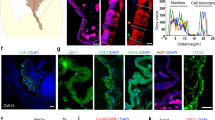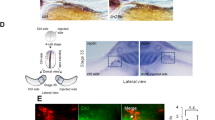Abstract
Notch3 has been studied in the context of brain development, but whether it plays a role in the formation of brain tumors is unclear. We demonstrate that the introduction of constitutively active Notch3 into periventricular cells of embryonic day 9.5 mice causes the formation of choroid plexus tumors (CPTs). Tumors arose in the fourth ventricles in 83% of animals and were associated with hydrocephalus. They were microscopically highly similar to choroid plexus papillomas in humans, with an ongoing proliferation rate of 4–6%. Signs of Notch pathway activity were also present in human choroid plexus lesions, and receptor mRNA levels in papillomas were elevated over those in non-neoplastic choroid plexus. Notch2 was overexpressed approximately 500-fold in one case, suggesting that the role of this pathway in CPTs may not be specific to Notch3. Our findings indicate that activated Notch3 can function as an oncogene in the developing brain, and link the Notch pathway to human CPT pathogenesis.
This is a preview of subscription content, access via your institution
Access options
Subscribe to this journal
Receive 50 print issues and online access
$259.00 per year
only $5.18 per issue
Buy this article
- Purchase on Springer Link
- Instant access to full article PDF
Prices may be subject to local taxes which are calculated during checkout




Similar content being viewed by others
References
Bellavia D, Campese AF, Amlesse E, Vacca A, Felli MP, Balestri A et al. (2000). EMBO J 19: 3337–3348.
Brinster RL, Chen HY, Messing A, van Dyke T, Levine AJ, Palmiter RD . (1984). Cell 37: 367–379.
Dang TP, Gazdar AF, Virmani AK, Sepetavec T, Hande KR, Minna JD et al. (2000). J Natl Cancer Inst 92: 1355–1357.
Fan X, Mikolaenko I, Elhassan I, Ni X, Wang Y, Ball D et al. (2004). Cancer Res 64: 7787–7793.
Gaiano N, Fishell G . (2002). Annu Rev Neurosci 25: 471–490.
Gaiano N, Nye JS, Fishell G . (2000). Neuron 26: 395–404.
Hallahan AR, Pritchard JI, Hansen S, Benson M, Stoeck J, Hatton BA et al. (2004). Cancer Res 64: 7794–7800.
Irvin DK, Nakano I, Paucar A, Kornblum HI . (2004). J Neurosci Res 75: 330–343.
Irvin DK, Zurcher SD, Nguyen T, Weinmaster G, Kornblum HI . (2001). J Comp Neurol 436: 167–181.
Iso T, Kedes L, Hamamori Y . (2003). J Cell Physiol 194: 237–255.
Kleihues P, Cavenee W . Tumors of the Nervous System. Lyon, France: IARC press, 2000.
Miyamoto Y, Maitra A, Ghosh B, Zechner U, Argani P, Iacobuzio-Donahue CA et al. (2003). Cancer Cell 3: 565–576.
Nickoloff BJ, Osborne BA, Miele L . (2003). Oncogene 22: 6598–6608.
Purow BW, Haque RM, Noel MW, Su Q, Burdick MJ, Lee J et al. (2005). Cancer Res 65: 2353–2363.
Radtke F, Raj K . (2003). Nat Rev Cancer 3: 756–767.
Rae FK, Stephenson SA, Nicol DL, Clements JA . (2000). Int J Cancer 88: 726–732.
Rickert CH, Wiestler OD, Paulus W . (2002). Am J Pathol 160: 1105–1113.
Solecki DJ, Liu XL, Tomoda T, Fang Y, Hatten ME . (2001). Neuron 31: 557–568.
Symonds H, Krall L, Remington L, Saenz-Robles M, Lowe S, Jacks T et al. (1994). Cell 78: 703–711.
Weng AP, Aster JC . (2004). Curr Opin Genet Dev 14: 48–54.
Yoon K, Nery S, Rutlin ML, Radtke F, Fishell G, Gaiano N . (2004). J Neurosci 24: 9497–9506.
Acknowledgements
We thank Dr Tetsuo Sudo for kindly providing Hes1 antibody. This work was supported by grants from the Children's Cancer Foundation and NINDS K08NS43279 to CGE, by a Kimmel Scholar Award to NG, and by NINDS K08NS041342 to MW. CGE, MW and NG are all recipients of Burroughs Wellcome Fund Career Awards in the Biomedical Sciences.
Author information
Authors and Affiliations
Corresponding authors
Rights and permissions
About this article
Cite this article
Dang, L., Fan, X., Chaudhry, A. et al. Notch3 signaling initiates choroid plexus tumor formation. Oncogene 25, 487–491 (2006). https://doi.org/10.1038/sj.onc.1209074
Received:
Revised:
Accepted:
Published:
Issue Date:
DOI: https://doi.org/10.1038/sj.onc.1209074
Keywords
This article is cited by
-
Identification of acquired Notch3 dependency in metastatic Head and Neck Cancer
Communications Biology (2023)
-
Aggresomes predict poor outcomes and implicate proteostasis in the pathogenesis of pediatric choroid plexus tumors
Journal of Neuro-Oncology (2021)
-
N-acetylcysteine decreases malignant characteristics of glioblastoma cells by inhibiting Notch2 signaling
Journal of Experimental & Clinical Cancer Research (2019)
-
Functional evaluation of alternative splicing in the FAM190A gene
Genes & Genomics (2019)
-
Sonic Hedgehog promotes proliferation of Notch-dependent monociliated choroid plexus tumour cells
Nature Cell Biology (2016)



